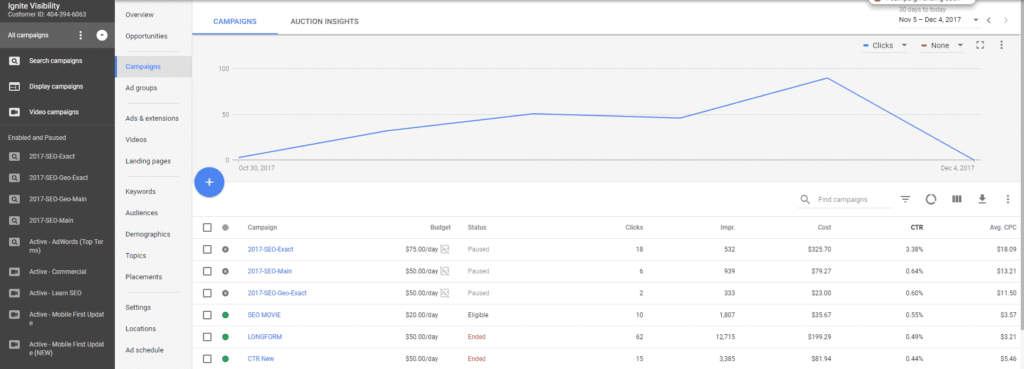Want more website traffic?
There is one simple SEO marketing strategy that I use to double my traffic, and in today’s post I teach you how to implement it.

SEO Marketing Strategy
It’s easier to get than you think, and it all starts with taking a good look at your click-through rate (CTR).
By improving your CTR, you’ll simultaneously improve your site’s traffic, and there’s one simple way to do it.
What is Click Through Rate (CTR) in Regards To SEO Marketing Strategy
Click through rate is how many time someone clicks on something (a link, page, ad, etc.) after seeing it a certain amount of times.
It comes down to a simple formula: Total clicks/Total impressions = CTR
For example, if your link has 100 impressions and a 2% CTR, that means that of the 100 people that saw your link, 2 people clicked through to your website.
You’re likely wondering what a “good” CTR is.
The answer? It depends, and the average varies by industry.
What Factors Influence CTR And SEO Marketing Strategy?
The main influences are:
- URL
- Title
- Descriptions
- Schema.org markup (rich snippets)
- Rel author, rel publisher, etc.
Basically, it comes down to SEO marketing.
Which means that when writing page titles, descriptions, and URLs, you need to make sure you’re doing it with an SEO frame of mind. Always include the search terms and keywords most likely to attract your audience.
Watch a video on this SEO strategy now!
Google Search Console for SEO Marketing
First step: analyzing the current levels of your CTR to set a baseline.
To do so, you’ll need Google Search Console.
You’ll want to measure two things: the CTRs of your search terms as well as your pages.
To look into search terms, log into your Google account and go to your Search Console. Select the right website and click “Search Traffic.” Then, go to the drop-down and click “Search Analytics.”
Once a chart appears, click the CTR checkbox at the top of the page. Your search terms and their corresponding CTRs will be shown at the bottom of the page.
This is where you can evaluate the levels of your search terms, and see which ones you should be incorporating more. You’ll also be able to identify the terms that are underperforming and work on replacing or improving them.

Google Search Console of SEO Marketing
Next, you’ll want to take a look at your individual page performance.
And once again, you’ll do so with Google Search Console. Follow all the steps above, but this time click the “Pages” button that appears above the chart.
This will show you pages by URL rather than search terms.

SEO Marketing Strategy
Now, take a deep look at each page, its CTR and the keywords associated with it. Determine which pages have the highest CTRs and which have the lowest.
You’ll be able to see pretty clearly where there’s room for improvement. Naturally, you want to see high percentages here. Anything that falls short should be flagged for additional work.
Now, pay special to pages that are performing well.
Take a close look at them, and try to determine why they deliver greater results. Remember the factors that most directly affect CTR.
Do they incorporate more high-performing keywords? Are their titles clearer, or descriptions more engaging? Do any of the pages have schema.org markup?
By zoning in on what separates your top performers from the rest of your pages, you’ll begin to see how you can improve those that receive lackluster CTRs.
Analyze Your Google AdWords for Better SEO Marketing Results
Another trick? Look at your ads.
In the same way that you compared your page performance, take a look at any Google AdWords campaigns you’ve run in the past to determine which had the best click-through rates.
To find the CTRs, log into your AdWords account and select “Campaigns.” Then, locate the “CTR” column.

SEO Marketing Strategy
Again, find your top performers and compare them to the pages in your Google Search Console that also saw the highest click-through rates.
Try to find any similarities between the two. For example, you might find that when you use humor – in both your ads and pages – you see higher CTRs. Or, maybe you’ve conveyed a sense of urgency that entices people to click.
Improve Your Titles and Descriptions for SEO Marketing Strategy
Once you’ve analyzed the content from your pages and ads, you’ll be able to apply what you’ve learned to the pages that see the lowest CTRs.
Start by developing a series of titles and descriptions for those pages. Remember, those are the two areas that show up in Google and therefore determine whether or not someone clicks.
Focus on improvement here, based on what you found in your page analysis. And always keep in mind, better titles plus better descriptions = higher CTR.
After you’ve put together new titles and descriptions, test them by using Fetch as Googlebot through Google Search Console.
Without getting too technical, Fetch as Googlebot is a feature that allows you to submit a URL to Google to perform a fresh crawl on your page.
To use it, log into your Search Console, click “Crawl” and then select “Fetch as Googlebot.”
From there, you’ll enter the URL you would like crawled. In this case, it’s any of the pages you’ve updated with new titles or descriptions.
This will allow you to test the effectiveness of your changes. Keep in mind, Google Search Console comes with a lag and may take a few days to see results.
Once the site is indexed with the new information, I recommend putting an annotation in Google analytics to save the information.
Now, you should be able to compare the page’s CTR before and after you made any updates.
For the most accurate results, give it a few weeks (you want at least a thousand visitors worth of data) before determining the overall effectiveness.
Hopefully, you’ll see a serious spike in your CTR, and be able to apply those changes to other pages on your site.
Check Templates For SEO Marketing
Page analysis alone may not solve all your CTR problems.
Keep in mind, titles and descriptions are often written on websites in templates.
So while a few individual pages may have their own unique descriptions, categories generally come in templates that are applied across the board.
If that’s the case with your site, making a few changes to the template could have a major impact on your overall CTR.
This could be a huge benefit, especially because we’re not just talking about one page here, but an entire section of your website that could potentially see much more traffic.
Consider Using Rich Snippets For Better SEO Marketing Results
Rich snippets are another area to pay close attention to when analyzing your CTR.
Rich snippets are added descriptions that Google shows users in search results. Google picks it; it could be a picture, review, rating, etc.
These are often added because you use schema.org – a piece of code that gives Google more information and signals that you have a high-quality site.
For example, if you’re looking up a tomato sauce recipe a normal snippet will show you the title, URL and brief description. But a rich snippet might add in a picture of the finished product, its star rating, cook time, and calorie count.
Naturally, the one with the rich snippet is likely to draw more eyes and ultimately, clicks. Therefore sites using something like schema.org and rich snippets will often see higher CTRs.
SEO Marketing Best Practices
When in doubt about how to improve your CTR, go back to SEO basics.
Remember:
- Don’t duplicate meta tags or descriptions
- Include keywords in your title tags
- Make sure titles are highly relevant
- Keep your descriptions to 160 characters, and make them as compelling as possible
Start Your SEO Marketing Strategy
So now you know, if you find your CTR rates are looking a little low, it’s time to take a good look at your SEO.
Analyze what’s working for your top pages, and apply what you see to those that could use a boost.
Measure their performance over a period of time, and wait for your CTR and traffic to reach new highs.